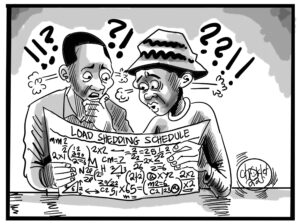ZESCO Limited has justified the $797,902,517.54 debt owed to local and cross border power suppliers, stating that the company is in a fix as it is buying power at a high cost and selling it at a lower cost.
In an interview, Zesco Limited senior corporate affairs manager Dr John Kunda said there was need to renegotiate the whole process.
The Auditor General’s Report on the Accounts of Parastatal Bodies and other Statutory Institutions for the financial year ended 31st December 2019 revealed that Zesco Limited owed local and cross border power suppliers in amounts totalling $797,902,517.54 as at 31st December 2020.
“In terms of our IPP relationship, we have never hidden the fact that the relationship is unsustainable because we are buying power on average of 11 cents to 12 cents. So, if you are buying power at a higher price and you are selling the same power below five cents to you as a customer, how do you expect the company to make money? You know that it is in public domain that we are trying to renegotiate those relationships. Then you know the Dollar/Kwacha relationship, whilst we are operating most of our obligations are in Dollar, the revenue that most of you are paying is in Kwacha,” Dr Kunda said.
“The issue of the IPP debt is known and the main difference in price differential; that is the generating tariff that we get from IPPs without considering [that] the transmission and distribution costs is above 11 cents and we are selling that same power at five cents. So, necessarily we are in a trap or a fix because there is no capacity. Because you have to find the difference to pay your IPP. So, what we need is a renegotiated position. Those are the efforts we have been engaging in. You cannot be [doing] business at a higher price and selling at a lower price and then miraculously hope that you will be able to find money somewhere to cover the differential. So those are some of the external factors that need to be attended to in the quest for enhancing the viability of the company.”
Dr Kunda said the power utility company had not defaulted on any payment and had been paying suppliers.
“Have we been paying anything? Definitely, if you reach out to the IPPs they will tell you what we pay them every month. It is not that we have been sleeping or sitting idle. So, there are certain obligations that we have to meet but they can tell you what they have been getting on a monthly basis looking at the relationship we have with them. So that is a known fact and that is an issue that needs to be dealt with extensively and in a very compressive way so that it is resolved now and forever to come. That has to be renegotiated and it is in Dollars. That process is a process that has been in discussion,” he said.
Dr Kunda said there was need to conclude the cost of service study to establish the true cost of the electricity production.
“Let’s say you are in business and you are producing a bag of maize at K10 and you are going to sell it at Soweto at K2, does it make business sense? It doesn’t. The same principle must apply in our case as Zesco Limited. So, we are also waiting for the cost-of-service study which ERB is engaged in because that cost-of-service study is going to benchmark what the true cost of service is in the electricity supply industry. It is not just good for Zesco, it is good for any player in the electricity supply industry. The problem is that people think that anything electricity is just good for Zesco. The sector must be attractive to private sector investment,” he said.
“Anyone who wants to do business in electricity generation, transmission and distribution must be willing to come into the field because there is money as well. And that you can run your business and meet your operational costs and be able to pay your workers confidently and comfortably. But as we speak now you can agree with me that there are so many people running into gold, diamonds, emeralds because the return on investment is promising. But whilst the electricity supply industry has been open, there are very few people rushing into it because people are looking on the return on investment whether foreign investors or local investors. The conditions for business may not favour return on investment that is attractive.”
Dr Kunda said there was no load shedding in the country as the company was producing more electricity than the current demand.
“First of all, just to be clear there is no load shedding at the moment anywhere in the country. Load shedding is defined as a deliberate switching power which is in deficit in order to preserve the resources that you have. In this case, I can confirm that we are generating at full capacity and we are meeting the current demand and exceeding the demand of the country. Our national installed capacity including all other power producers is at 3,644 megawatts. So, we have excess, Zesco’s own capacity is at 2,657 megawatts. The peak demand for this country is at 2,410 megawatts. So, you can see that what this country needs is way below what we are able to generate. So, we are able to meet the demand” said Dr Kunda.
“Then that raises a question: why are certain areas in Lusaka losing power? I can be very specific because the places that are losing power are known. It is Avondale along Acacia Avenue, you will be looking at places in Mtendere East, Salama Park, Ibex Hill, and then parts of Chainda. Then the Obama area gets affected as well. The reason is very clear, we have been working on the Lusaka transmission, distribution and rehabilitation project which is upgrading the infrastructure in the city of Lusaka. The programme is funded by the World Bank and European Investment Bank, it is worth $260 million. So, the substation in Leopards Hill was being rehabilitated and upgraded.”


















